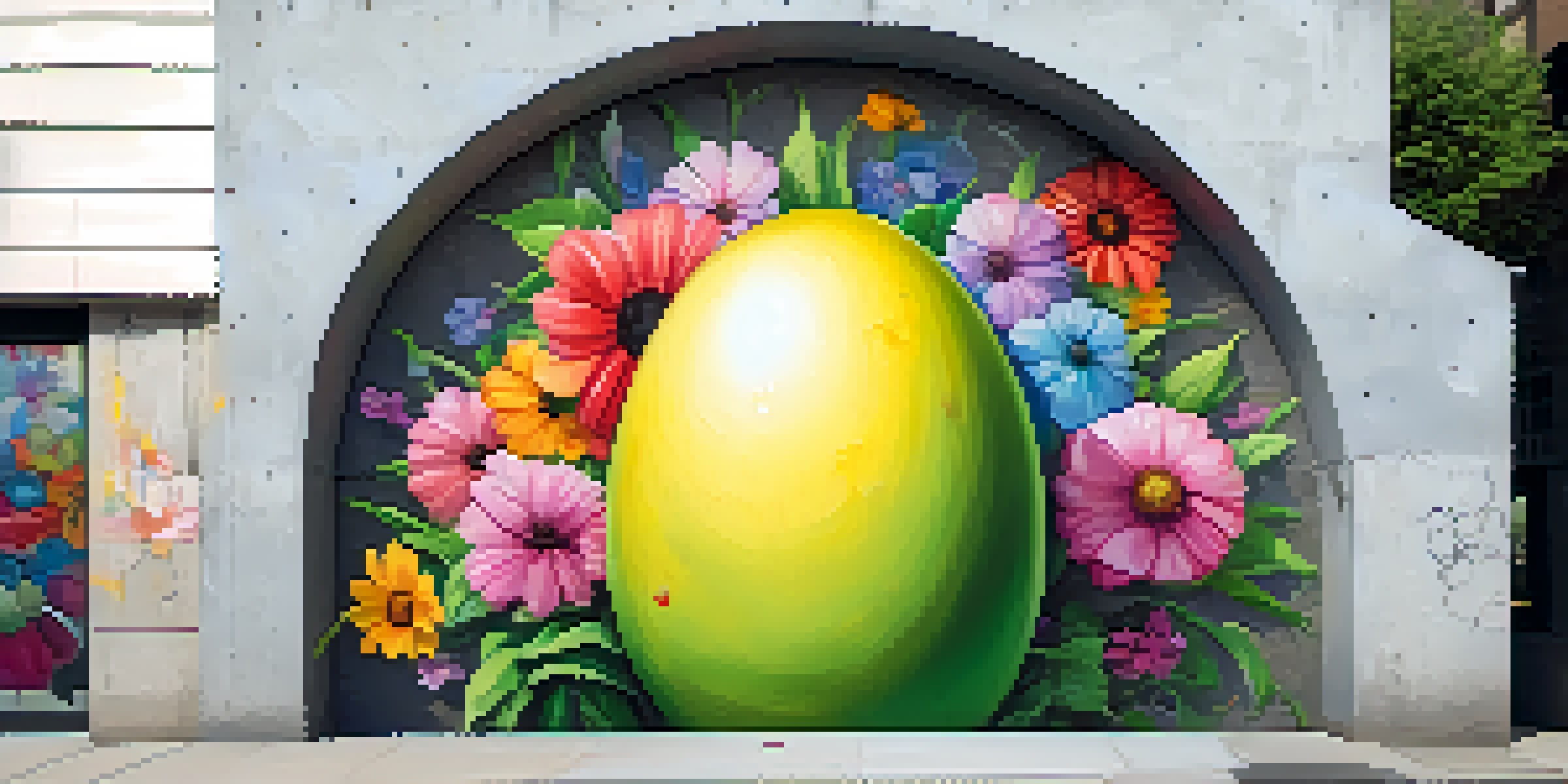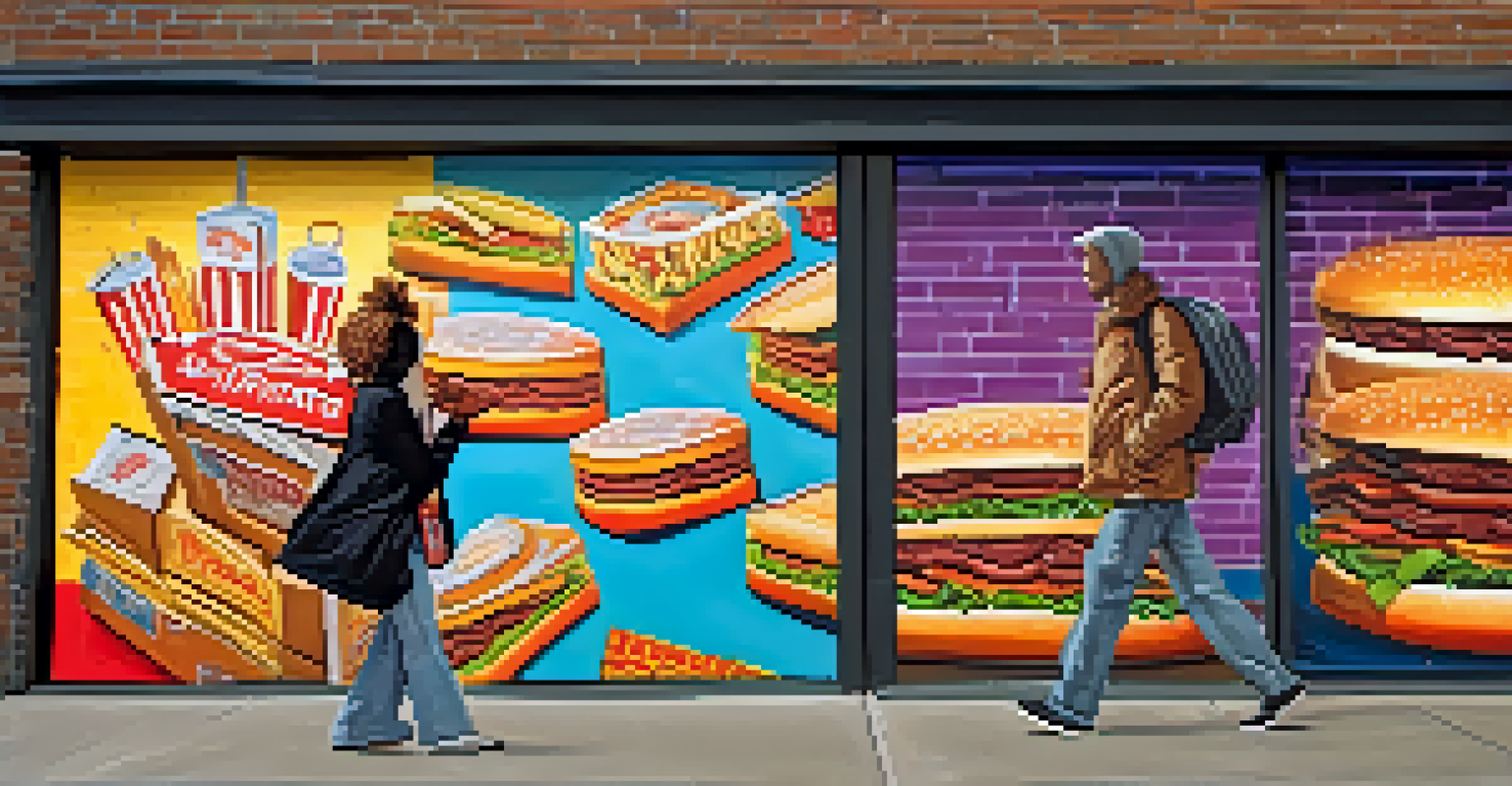The Role of Street Art in Anti-Consumerism Movements

Understanding Street Art as a Voice for the Voiceless
Street art often serves as a powerful medium for social commentary, giving a voice to those marginalized by mainstream culture. Unlike traditional art forms, which may be confined to galleries and elite spaces, street art thrives in public domains, making it accessible to everyone. This accessibility allows artists to express dissent against consumerism directly to the public, fostering a dialogue about societal values and materialism.
Art should comfort the disturbed and disturb the comfortable.
For instance, murals that critique corporate greed or satirize product culture invite viewers to reflect on their own consumption habits. These artworks become a form of protest, challenging viewers to reconsider what they value in their lives beyond material possessions. By transforming urban spaces into canvases for social critique, street art reclaims public dialogue from commercial interests.
Moreover, the ephemeral nature of street art—often painted over or removed—mirrors the fleeting nature of consumer goods themselves. This transience adds urgency to the messages conveyed, prompting audiences to engage with the art and its implications quickly before it disappears. Thus, street art not only beautifies urban landscapes but also serves as a catalyst for conversations about consumerism and its impact on society.
The Evolution of Anti-Consumerism Themes in Street Art
Historically, street art has evolved from simple graffiti to a sophisticated form of social commentary, particularly in its critique of consumerism. Artists like Banksy and Shepard Fairey have popularized anti-consumerist themes, using their art to spotlight the absurdities of capitalism. Their work often combines humor with stark imagery, making heavy topics more relatable and engaging for the public.

This evolution reflects a broader cultural shift where artists began to see the potential of street art as a platform for activism. The rise of consumer culture in the late 20th century provided fertile ground for artists to explore themes of excess, branding, and the commodification of everyday life. As a result, street art has become an essential tool for challenging the status quo and pushing back against the relentless tide of consumerism.
Street Art Amplifies Social Voices
Street art acts as an accessible platform for marginalized communities to express dissent against consumerism and engage the public in critical dialogue.
In contemporary settings, street art continues to adapt and respond to the changing landscape of consumer culture. New artists emerge, often influenced by social media and global issues, to create art that resonates with a modern audience. This constant evolution ensures that anti-consumerism remains a relevant theme, encouraging ongoing dialogue about our relationship with consumption.
How Street Art Engages Communities in Dialogue
One of the most powerful aspects of street art is its ability to engage local communities in conversations about their values and choices. When artists create works that challenge consumerism, they often inspire residents to think critically about their own spending habits and the influence of advertising on their lives. This engagement fosters a sense of community, as people share their thoughts and feelings about the messages conveyed through the art.
The greatest crimes in the world are not committed by people breaking the rules but by people following the rules. It's a different perspective of what we consider crime and what we consider art.
For example, public art projects that involve community participation can transform streets into open forums for discussion. Workshops and collaborative painting sessions not only enrich the artistic process but also empower individuals to express their perspectives on consumer culture. Such initiatives help bridge the gap between artists and audiences, making the conversation about anti-consumerism more inclusive and personal.
Additionally, street art can illuminate local issues related to consumerism, such as gentrification or the impact of big corporations on small businesses. By addressing these topics, artists encourage communities to unite against common challenges and advocate for alternative values. This grassroots approach to activism is vital for fostering meaningful change and encouraging collective action against consumer-driven society.
The Role of Humor and Satire in Anti-Consumerism Art
Humor and satire play a crucial role in street art, particularly in its approach to anti-consumerism. Artists often use irony and wit to critique consumer culture, making their messages more digestible for the public. This clever use of humor not only entertains but also provokes thought, inviting viewers to laugh while simultaneously challenging them to reflect on their consumer habits.
For instance, satirical works that exaggerate the excesses of consumerism can effectively highlight the absurdity of certain behaviors, like queueing for the latest gadgets or brand-name products. By presenting these concepts in a humorous light, artists create an emotional connection with viewers, making the critique feel relatable rather than preachy. This approach can be a powerful way to encourage individuals to question their own participation in consumer culture.
Humor Engages Anti-Consumerism
Artists use humor and satire in street art to make critiques of consumer culture relatable, inviting reflection on individual consumption habits.
Moreover, humor can serve as a coping mechanism for individuals feeling overwhelmed by the pressures of modern consumerism. Street art that uses lightheartedness to address serious issues allows viewers to engage with uncomfortable truths without feeling defensive. As a result, this blend of humor and critique can inspire positive change, encouraging people to rethink their values in a more approachable manner.
Street Art as a Tool for Global Anti-Consumerism Movements
The reach of street art extends beyond local communities; it has the potential to impact global anti-consumerism movements. Artists worldwide use their talents to comment on shared issues related to consumer culture, creating a network of activism that transcends borders. This global collaboration amplifies the message, reaching diverse audiences and fostering solidarity among those who challenge consumerism.
For example, international street art festivals often showcase works that critique global brands and the impact of capitalism on local cultures. These events provide a platform for artists from different backgrounds to share their perspectives and experiences, highlighting the universal consequences of consumerism. By connecting artists and activists across the globe, street art becomes a unifying force in the fight against excessive consumer culture.
Additionally, social media has played a significant role in amplifying street art's global reach. Artists can share their work online, allowing it to resonate with audiences far beyond its physical location. This digital presence not only encourages discussions about anti-consumerism but also inspires new artists to join the movement. As street art continues to evolve, its potential to influence global conversations about consumer culture remains an essential aspect of its power.
The Connection Between Street Art and Sustainable Living
As anti-consumerism movements gain momentum, many street artists are also embracing themes related to sustainability. By critiquing consumer culture, these artists often highlight the environmental impact of mass consumption and waste. This connection between street art and sustainable living encourages viewers to consider how their choices affect the planet, fostering a more holistic understanding of the issues at hand.
For instance, murals that depict the consequences of overconsumption—like pollution or deforestation—serve as visual reminders of the urgent need for sustainable practices. Such artworks not only raise awareness but also inspire individuals to adopt eco-friendly habits in their daily lives. By linking anti-consumerism with sustainability, street art encourages a more profound reflection on the interconnectedness of social and environmental issues.
Global Impact of Street Art
Street art fosters global anti-consumerism movements by connecting artists worldwide and amplifying messages against excessive consumer culture.
Moreover, street artists often utilize recycled materials or sustainable techniques in their work, further reinforcing their commitment to environmental responsibility. This hands-on approach demonstrates that art can be both impactful and sustainable, challenging the notion that consumerism is the only path to creativity. By promoting sustainable living through street art, artists contribute to a larger movement that seeks to redefine success and fulfillment beyond material accumulation.
Future Directions for Street Art in Anti-Consumerism
Looking ahead, street art's role in anti-consumerism movements will likely continue to evolve as new challenges arise. With the ever-changing landscape of consumer culture—especially in the digital age—artists will need to adapt their messages and mediums to resonate with contemporary audiences. This adaptability will be crucial in maintaining the relevance and effectiveness of street art as a form of protest.
Innovative techniques, such as augmented reality and interactive installations, could provide fresh ways for artists to engage viewers and convey anti-consumerism messages. These modern approaches can enhance the emotional impact of the art, making it even more compelling for audiences. As technology continues to shape our lives, street art must harness these advancements to reach and inspire a broader audience.

Moreover, the growing emphasis on social justice and environmental issues will likely influence the themes explored in street art. As more artists align their work with these values, the anti-consumerism movement can strengthen its ties to other vital causes. By fostering collaboration between street artists and various activist groups, the future of street art in anti-consumerism promises to be dynamic and impactful, driving meaningful change in society.